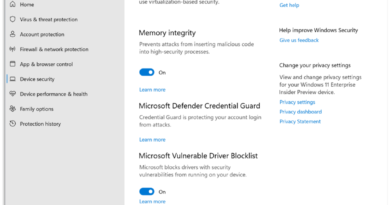A guide to balancing external threats and insider risk

The security community is continuously changing, growing, and learning from each other to better position the world against cyber threats. In the latest Voice of the Community blog series post, Microsoft Product Marketing Manager Natalia Godyla talks with Rockwell Automation Vice President and Chief Information Security Officer Dawn Cappelli. In this blog post, Dawn talks about the importance of including insider risk in your cybersecurity plan.
Natalia: What is the biggest barrier that organizations face in addressing insider risk?
Dawn: The biggest barrier is drawing attention to insider risk. We heard about the ransomware group bringing down the Colonial Pipeline. We hear about ransomware attacks exposing organizations’ intellectual property (IP). We’re not hearing a lot about insider threats. We haven’t had a big insider threat case since Edward Snowden so that sometimes makes it hard to get buy-in for an insider risk program. But I guarantee insider threats are happening. Intellectual property is being stolen and systems are being sabotaged. The question is whether they are being detected—are companies looking?
Natalia: How do you assess the success of an insider risk program?
Dawn: First, we measure our success by significant cases. For instance, we have someone leaving the company to go to a competitor, we catch them copying confidential information that they clearly want to take with them, and we get it back.
Second, we measure success by looking at the team’s productivity. Everyone in the company has a risk score based on suspicious or anomalous activity as well as contextual data, for instance, they are leaving the company. Every day we start at the top of the dashboard with the highest risk and work our way down. We look at how many cases have no findings because that means we’re wasting time, and we need to adjust our risk models to eliminate false positives.
We also look at the reduction in cases because we focus a lot on deterrence, communication, and awareness, as well as cases by business unit and by region. We run targeted campaigns and training for specific business units or types of employees, regions, or countries, and then look at whether those were effective in reducing the number of cases.
Natalia: How does measuring internal threats differ from measuring external threats?
Dawn: From an external risk perspective, you need to do the same thing—see if your external controls are working and if they’re blocking significant threats. Our Computer Security Incident Response Team (CSIRT) also looks at the time to contain and the time to remediate. We should also measure how long it takes to respond and recover IP taken by insiders.
By the way, I like using the term “insider risk” instead of “insider threat” because we find that most suspicious insider activity we detect and respond to is not intentionally malicious. Especially during COVID-19, we see more employees who are concerned about backing up their computer, so they pull out their personal hard drive and use it to make a backup. They don’t have malicious intent, but we still must remediate the risk. Next week they could be recruited by a competitor, and we can’t take the chance that they happen to have a copy of our confidential information on a removable media device or in personal cloud storage.
Natalia: How do you balance protecting against external threats and managing insider risks?
Dawn: You need to consider both. You should be doing threat modeling for external threats and insider risks and prioritizing your security controls accordingly. An insider can do anything an external attacker can do. There was a case in the media recently where someone tried to bribe an insider to plug in an infected USB drive to get malware onto the company’s network or open an infected attachment in an email to spread the malware. An external attacker can get in and do what they want to do much easier through an insider.
We use the National Institute of Standards and Technology (NIST) Cybersecurity Framework (CSF) for our security program, and we use it to design a holistic security program that encompasses both external and insider security risks. For example, we identify our critical assets and who should have access to them, including insiders and third parties. We protect those assets from unauthorized access—including insiders and outsiders. We detect anomalous or suspicious behavior from insiders and outsiders. We respond to all incidents and recover when necessary. We have different processes, teams, and technologies for our insider risk program, but we also use many of the same tools as the CSIRT, like our Security Information and Event Management (SIEM) and Microsoft Office 365 tools.
Natalia: What best practices would you recommend for data governance and information protection?
Dawn: Don’t think about insider threats only from an IP perspective. There’s also the threat of insider cyber sabotage, which means you need to detect and respond to activities like insiders downloading hacking tools or sabotaging your product source code.
Think about it: an external attacker has to get into the network, figure out where the development environment is, get the access they need to compromise the source code or development environment, plant the malicious code or backdoor into the product—all without being detected. It would be a lot easier for an insider to do that because they know where the development environment is, they have access to it, and they know how the development processes work.
When considering threat types, I wouldn’t say that you need to focus more on cyber sabotage than IP; you need to focus on them equally. The mitigations and detections are different for IP theft versus sabotage. For theft of IP, we’re not looking for people trying to download malware, but for sabotage, we are. The response processes are also different depending on the threat vector.
Natalia: Who needs to be involved in managing and reducing insider risk, and how?
Dawn: You need an owner for your insider risk program, and in my opinion, that should be the Chief Information Security Officer (CISO). HR is a key member of the virtual insider risk team because happy people don’t typically commit sabotage; it’s employees who are angry and upset, and they tend to come to the attention of HR. Every person in Rockwell HR takes mandatory insider risk training every year, so they know the behaviors to look for.
Legal is another critical member of the team. We can’t randomly take people’s computers and do forensics for no good reason, especially in light of all the privacy regulations around the world. The insider risk investigations team is in our legal department and works with legal, HR, and managers. For any case involving personal information and any case in Europe, we go to our Chief Privacy Officer and make sure that we’re adhering to all the privacy laws. In some countries, we also have to go to the Works Council and let them know we’re investigating an employee. The security team is responsible for all the controls—preventive, detective—technology, and risk models.
Natalia: What’s next in the world of data regulation?
Dawn: Privacy is the biggest issue. The Works Councils in Europe are becoming stronger and more diligent. They are protecting the privacy of their fellow employees, and the privacy review processes make the deployment of monitoring technology more challenging.
In the current cyber threat environment, we must figure out how to get security and privacy to work together. My advice to companies operating in Europe is to go to the Works Councils as soon as you’re thinking about purchasing new technology. Make them part of the process and be totally transparent with them. Don’t wait until you’re ready to deploy.
Natalia: How will advancements like cloud computing and AI change the risk landscape?
Dawn: We have a cloud environment, and our employees are using it to develop products. From inception, the insider risk team worked to ensure that we’re always threat modeling the environment. We go through the entire NIST CSF for that cloud environment and look at it from both an external and insider risk perspective.
Companies use empirical, objective data to create and train AI models for their products. The question becomes, “Do you have controls to identify an insider who deliberately wants to bias your models or put something malicious into your AI models to make it go off course later?” With any type of threat, ask if an insider could facilitate this type of attack. An insider can do anything an outsider can do, and they can do it much easier.
Learn more
To learn more about Microsoft Security solutions, visit our website. Bookmark the Security blog to keep up with our expert coverage on security matters. Also, follow us at @MSFTSecurity for the latest news and updates on cybersecurity.
READ MORE HERE



